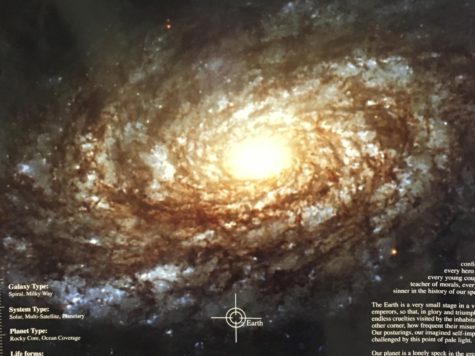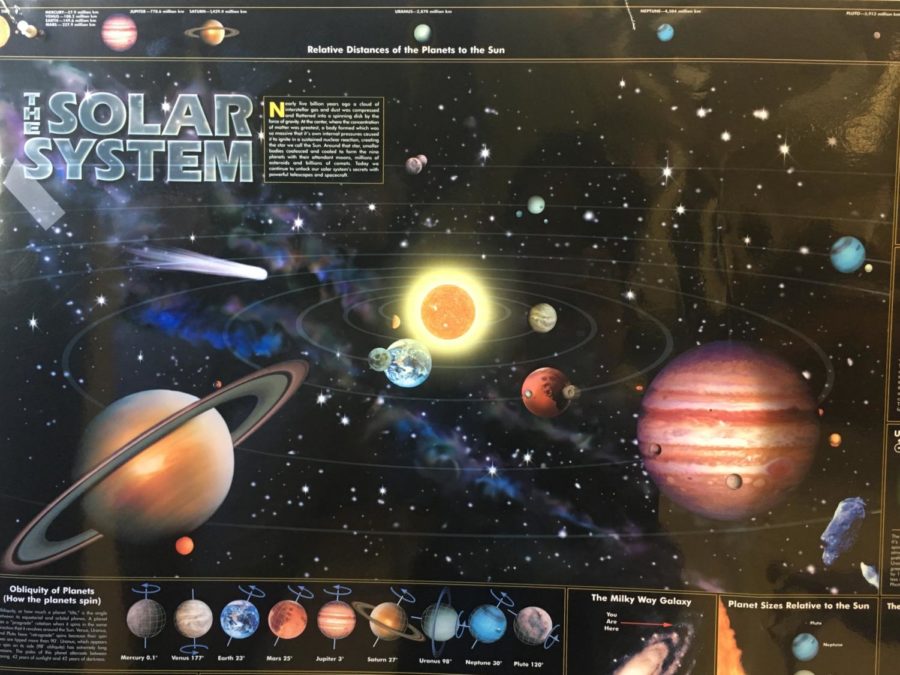Space: The Current Frontier
A detailed diagram of our solar system.
What if we are not as alone in the universe as we think? In the past two months alone, two major breakthroughs have occurred: InSight, a rover sent to Mars, and a Harvard study of an unknown object soaring through the sky, defying laws.
On November 26, 2018, at NASA’s Jet Propulsion Lab in California, a billion dollar project flew to life as it reached its final destination some 55 million kilometers away: Mars. ‘Interior Exploration using Seismic Investigations, Geodesy and Heat Transport,’ or InSight for short, was sent to investigate seismic activity and the geology of Mars, as to compare and contrast to Earth. Data gathered would not only help us understand the formation of our planet, but our solar system as well.
Back here on Earth, only weeks earlier, a Harvard study released a paper suggesting that ‘Oumuamua, a ‘space rock,’ was not actually a space rock, but instead an interstellar piece of alien technology. As it sped through the sky over Hawaii in 2017, astronomers were fascinated by its unusual shape, low thermal energy, and out of this world acceleration. Research began quickly, and the simplest explanation? Aliens.
As InSight approached Mars, many were hopeful for its success. Its first picture gave way into the rocky red planet that looks more like a desert than an life enabling environment. However, “Life has always surprised us with how it exists,” states Anthony Wasley, a science teacher at Hall High School. “By looking at other planets, you can support theories.” Wasley went on to note that this could help us understand our environment and how humans could be affecting Earth. The purpose of the InSight mission is to understand the general geological history of Mars through soil samples. With this information we can find out many things; if it has a magnetic field, tectonic plates, and even liquid layers.
Research is not only done to support theories of the universe– it can also be done out of our own curiosity and fascination with the unknown. That seems to be the main motivation behind looking into ‘Oumuamua, the name given to the unidentified interstellar object. According to CNN, ‘Oumuamua means “‘a messenger that reaches out from the distant past’” in Hawaiian, and was discovered in October of last year. A study conducted by Harvard professors Shmuel Bialy and Abraham Loeb leads them to believe that ‘Oumuamua may be extraterrestrial technology– specifically, a solar-powered sail of a spacecraft, or an alien probe to investigate planet Earth.
But not everyone is a fan of Bialy and Loeb’s conclusions. Norman Burtness, a physics teacher at Hall High, thinks that “a lot of this [belief in aliens] is hopefulness.” If ‘Oumuamua came from another part of the Milky Way, it’s fairly likely that the object’s strange characteristics stem from things we don’t know, things we simply don’t understand yet. Even Wasley, who “think[s] aliens exist without a doubt,” says that ‘Oumuamua is “probably nothing.” He attributes the anomalies of the asteroid to its oblong shape.
Alan Jackson, a fellow at the Centre for Planetary Sciences in the University of Toronto, published his own paper on ‘Oumuamua in March of 2018, theorizing that the rock came from a binary (two) star system. Jackson refutes most of Harvard’s claims, emphasizing that solar sails cannot change course and one would be able to trace a sail back to its origin; yet, the origin of ‘Oumuamua is unknown. Alas, only guesses can be made at this point, since ‘Oumuamua has left our solar system and will not be coming back. Loeb, one of the authors himself, says, “It is impossible to guess the purpose behind ‘Oumuamua without more data.”
Although many questions about the interstellar object exist, it’s the speculation that scientists live for. “The thing you have to understand is: scientists are perfectly happy to publish an outlandish idea if it has even the tiniest ‘sliver’ of a chance of not being wrong,” tweeted Katie Mack, an astrophysics professor at North Carolina State University. “But until every other possibility has been exhausted dozens of times over, even the authors probably don’t believe it.” People have constantly wondered why aliens haven’t contacted Earth, and the likelihood is that no other life has the ability to contact us in the first place. After all, there is no center of the universe. As the universe expands, anything with matter moves away from each other, similar to putting two negative magnets together. As the days pass with no connection to other planets, we are drifting farther and farther away from extraterrestrial life.

A diagram of the Milky Way Galaxy, with Earth specifically pointed out.






